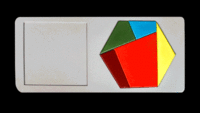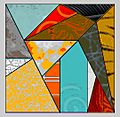Dissection puzzle facts for kids
A dissection puzzle is a fun challenge where you take a set of pieces and arrange them to make different shapes. Think of it like a jigsaw puzzle, but instead of one picture, you can make many different designs! Sometimes, these puzzles are called transformation puzzles or Richter Puzzles. People who create new dissection puzzles try to use the fewest pieces possible. They also look for new and interesting ways to connect the pieces, like using hinges so pieces can swing open.
Contents
Discovering Dissection Puzzles
What Kinds of Shapes Can You Make?
Some dissection puzzles are made to create many different geometric shapes. A famous example is the tangram. This puzzle has seven flat pieces, called "tans." You can arrange these pieces to form a large square or rectangle, which is how they are often stored. But the real fun is using them to create countless other shapes! You can make smaller squares, triangles, or even animal figures. Some shapes are easy to make, while others are a real brain-teaser. This variety is why the tangram is so popular!
Transforming One Shape into Another
Other dissection puzzles are designed to change one specific shape into another. For example, you might transform a triangle into a square, or a square into a five-pointed star.
The Haberdasher's Problem
One classic example is the haberdasher's problem. This puzzle was created in 1907 by a puzzle master named Henry Dudeney. It shows how to cut an equilateral triangle (a triangle with all sides equal) into just four pieces. Then, you can rearrange these four pieces to form a perfect square! It's one of the simplest ways known to change a regular polygon into a square.
The Missing Square Puzzle
The missing square puzzle is a bit different. It's an optical illusion that tricks your eyes. When you rearrange the pieces of this puzzle, it looks like a small part of the area has disappeared or appeared. Even though the pieces are the same, the way they are moved makes it seem like the total area has changed, which is impossible! It's a clever trick that shows how our brains can be fooled by what we see.
-
A Tangram puzzle, with its pieces in the rectangular "storage" configuration.
Images for kids
-
Ostomachion is a dissection puzzle attributed to Archimedes





